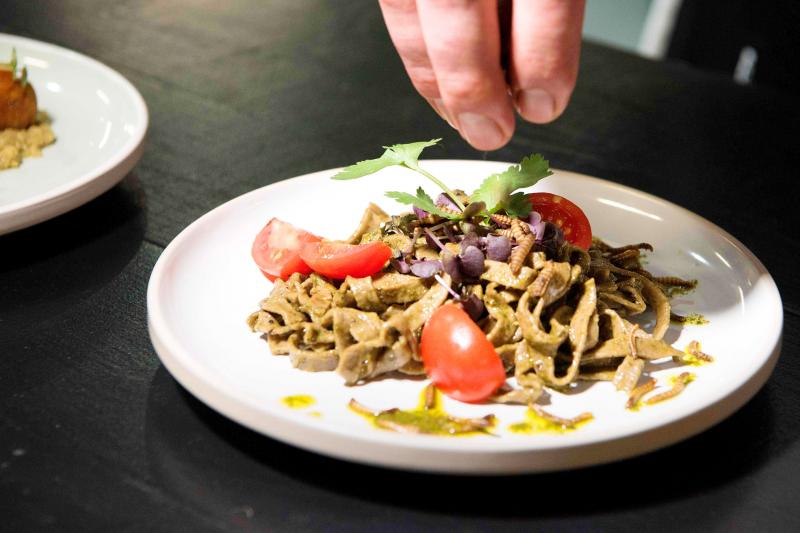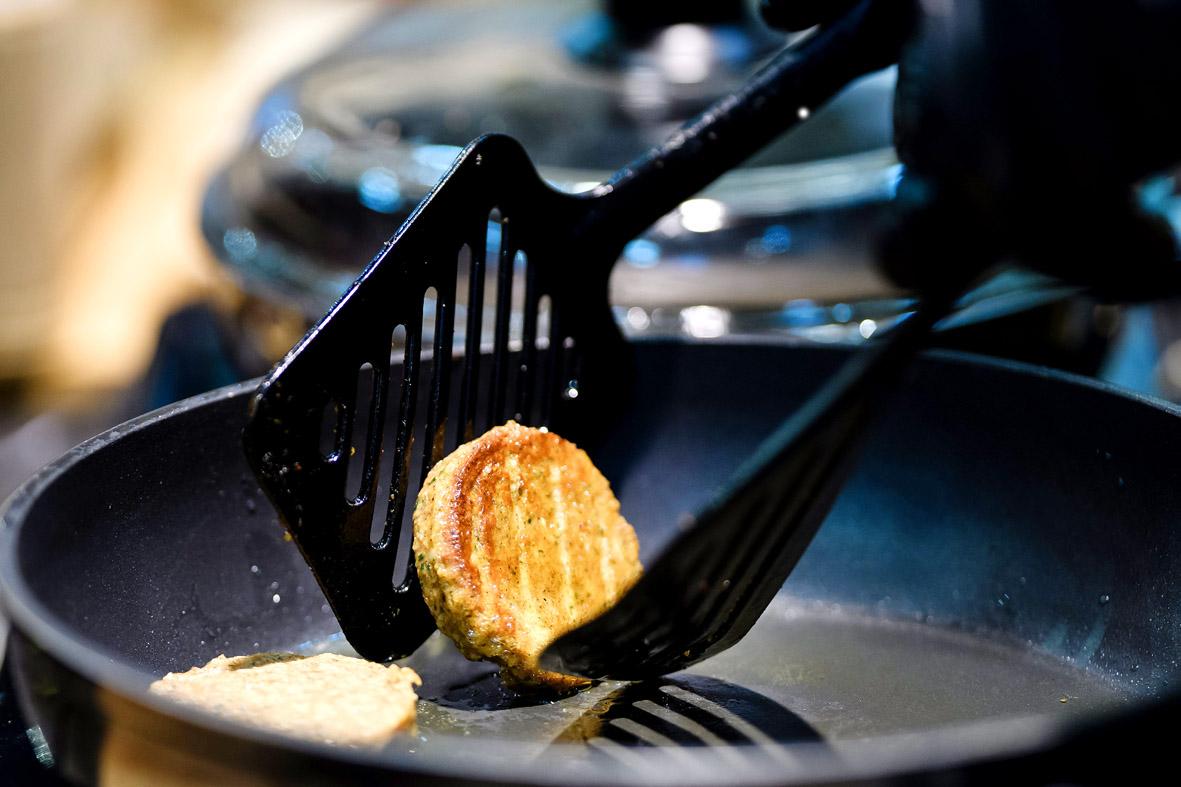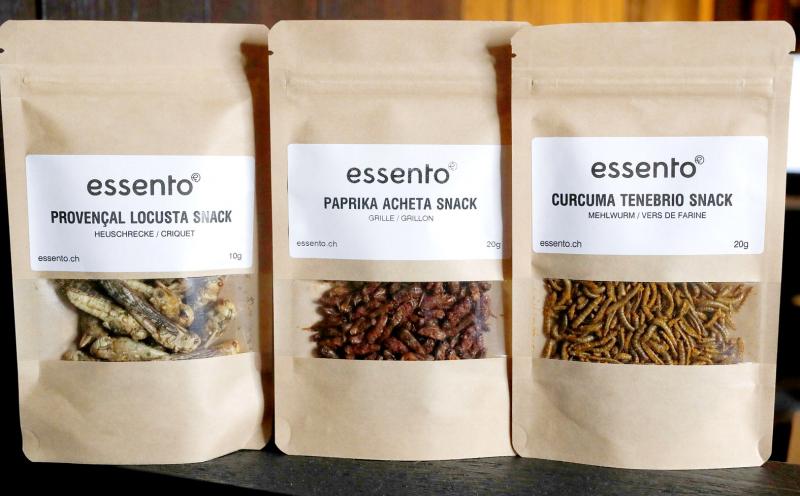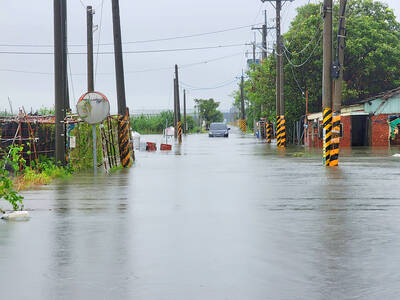It’s a bit … well, mealy. Dry (because it’s been dried), a little crunchy, not strongly flavored, neither pleasant nor unpleasant. Salt would probably help, or chilli, lime — something, anything, to spice it up a bit. And definitely a beer, if I was going to consume much more, to help wash it down.
I’m eating mealworms. Dried yellow mealworms, the larvae of the beetle Tenebrio molitor. Why? Because they are nutritious, made up mainly of protein, fat and fiber. Because there are potentially environmental and economic benefits, as they require less feed and produce less waste and carbon dioxide than other sources of animal protein. And because Efsa, the EU food safety agency, has just declared them safe to eat.
We already had some in, as it happens — a big bagful. We put them out for the birds. Batman the robin is particularly fond of them.

Photo: AFP
There’s no getting around the fact they do look like maggots, though, because that’s essentially what they are, and this feels more like a bushtucker trial than a meal. So I’m thinking maybe dipping them in melted chocolate might help disguise them …
Now they look like maggots dipped in chocolate, but at least they taste of something — chocolate. With a bit of texture inside, not unlike fruit and nut. That’s when I spot it on the mealworm packet: “Not for human consumption.”
Surely a dried mealworm is a dried mealworm, and if they’re not doing little Batman any harm, they’re not going to kill me? Still, better safe than sorry, so I order some ready-to-eat mealworms, fit for human consumption, online from a company called Crunchy Critters. These are £4.98 for two 10g packets (or £249 a kilo, US$340) compared with £13.99 for half a kilo for the ones we get for the birds.

Photo: EPA-EFE
WHAT’S IN A WORM?
The farming process involves separating the eggs from mating adult beetles, then feeding the larvae cereal such as oats or wheat bran, plus vegetables. When they have grown, they are rinsed, killed by immersion in boiling water and then dried in ovens. Or you can build a DIY mealworm farm at home, using a plastic container with drawers and feeding them oats and vegetables; there are videos on YouTube that show you how. Who doesn’t want a little multistorey maggot-making factory in the home?
Anyway, the conclusion from EFSA — which is expected to lead to EU-wide approval and could soon see packets of mealworms and mealworm flour on supermarket shelves across the continent — followed an application from a French insect-for-food production company called Agronutris. There are several other applications for insect-based food under consideration, including types of crickets, locusts and lesser mealworms (also known as litter beetles, mmmmm).

Photo: REUTERS
It was already legal to sell insects as human food in the UK, even when we were part of the EU — Crunchy Critters has been offering them since 2011 — but the EFSA’s ruling ends years of uncertainty across the continent and is expected to give the mealworm market a huge boost.
Wolfgang Gelbmann, senior scientific officer in the nutrition unit of EFSA, explains the two questions the agency asks when considering a novel food.
“Firstly, is it safe, and second, is it nutritiously disadvantageous for the European consumer if it is introduced into our diet? Novel foods are not required by the novel food regulation to be healthy — they are not intended to improve the European diet — but they should not be worse than what we are already consuming.”
Although it is not the EFSA’s job to assess the nutritional value or the economic and environmental benefits of mealworms, Gelbmann says this will depend on how they are produced. “The more you produce, the cheaper it will be. It will largely depend on what you feed the animals, but also on the energy and water input.”
As well as emitting less CO2 and requiring less water and land than traditional livestock, insects turn feed into protein more efficiently. The Food and Agriculture Organization of the UN reports that crickets, for example, require only 2kg of feed for every 1kg of bodyweight gain.
Gelbmann doesn’t dispute the protein content of mealworms, but says it is not as high as meat, milk or eggs, “more in the area of quality plant protein, like rapeseed or soya.”
Leo Taylor, the co-founder of the British company Bug, which plans to market insect food kits — kind of creepy-crawly ready meals — is in no doubt about the benefits.
“Mealworms can be farmed in a much more intensive way than you can traditional livestock. You can also feed them fruit and veg waste,” Taylor says.
Are they actually nice to eat, though?
“It depends on how you cook them,” he says. “We think they are delicious and we’re not the only ones. Eighty per cent of countries around the world eat insects in some form — over 2 billion people — and not because they have to but because they’re tasty. I’m half Thai and I grew up a lot in south-east Asia, eating insects as a child.”
He has a recipe for a delicious Thai-influenced mealworm butternut soup, for when my safe-for-human-consumption mealworms turn up.
“Nice and warmhearted for this time of year,” he says.
Sounds perfect; I’m just wondering whether the rest of my family will agree.
YUCK FACTOR
That — the yuck-factor — is the big hurdle, says Giovanni Sogari, a social and consumer behavior researcher at Parma University, who published a book on the subject of eating insects.
“Since the beginning of humankind we have been eating insects in parts of the world; right now there are 2,000 species considered to be edible,” he says. “But of course in Europe, in the US, in the global north, consumers have this rejection towards insects, which is mainly due to a sense of disgust. Just because we don’t consider them food, we are not willing to eat them.”
Sogari says studies have shown that if you have previously been exposed to edible insects, on a holiday abroad perhaps, you are more likely to try them again. Also that people from northern European countries have a higher probability of acceptance than people from Mediterranean countries. Age is a factor too — the elderly are less likely to experiment.
“If young people start to like it, then the market will grow,” he says. He points to the increased popularity of sushi; if it can happen with raw fish, fish eggs, seaweed, “who knows, it could happen with insects.”
“If I show you a picture of a scorpion and a picture of a lobster or some other crustacean, they’re not so different,” he points out.
But it’s still easier to feed people insects if they’re not recognizable. Mealworms can be made into flour, pasta, cupcakes, burgers, smoothies; I’m wondering whether I should have started out with something less obviously maggoty.
Here they are though, mealworms for humans, fresh from the Internet. Well, dried from the Internet, and delivered to my door. And looking very much the same as the bird food. Tasting the same too — ie, of not a lot. Yet. But I’m going to turn them into Leo Taylor’s butternut soup, with an onion, garlic, a little green curry powder, coconut milk, stock, a splash of fish sauce, lime. Half of the mealworms, which I have roasted in the oven with a bit of red curry sauce because we don’t have any Thai seasoning, get buzzed up with the soup; the rest are sprinkled on top with a little coriander and chilli.
You know what? It’s actually not bad. Tangy. You wouldn’t know there was anything in the soup that once wriggled, but think of all that lovely extra protein. And the garnish gives it a nice bit of crunch as well as novelty factor. I think I’ll go lighter on the coconut next time … if there is a next time. Let’s see. Lunch!
“Euuurgh!” go the kids, aged six and eight. “Yuk!” “What the …” “No way! And worse. Mutiny, tantrums, tears and empty tummies. Too big a step perhaps, the sprinklies. Maybe I should have pretended they were little shrimps? To be fair, they’re not the most open-minded when it comes to food — won’t even eat fish if it looks too much like fish. We should have started with pasta, or burgers, or cupcakes. Or had more exciting holidays. Because it doesn’t matter that EFSA says they are safe — it seems one unadventurous European family isn’t quite ready for mealworms.

Following the shock complete failure of all the recall votes against Chinese Nationalist Party (KMT) lawmakers on July 26, pan-blue supporters and the Chinese Communist Party (CCP) were giddy with victory. A notable exception was KMT Chairman Eric Chu (朱立倫), who knew better. At a press conference on July 29, he bowed deeply in gratitude to the voters and said the recalls were “not about which party won or lost, but were a great victory for the Taiwanese voters.” The entire recall process was a disaster for both the KMT and the Democratic Progressive Party (DPP). The only bright spot for

Water management is one of the most powerful forces shaping modern Taiwan’s landscapes and politics. Many of Taiwan’s township and county boundaries are defined by watersheds. The current course of the mighty Jhuoshuei River (濁水溪) was largely established by Japanese embankment building during the 1918-1923 period. Taoyuan is dotted with ponds constructed by settlers from China during the Qing period. Countless local civic actions have been driven by opposition to water projects. Last week something like 2,600mm of rain fell on southern Taiwan in seven days, peaking at over 2,800mm in Duona (多納) in Kaohsiung’s Maolin District (茂林), according to

Aug. 11 to Aug. 17 Those who never heard of architect Hsiu Tse-lan (修澤蘭) must have seen her work — on the reverse of the NT$100 bill is the Yangmingshan Zhongshan Hall (陽明山中山樓). Then-president Chiang Kai-shek (蔣介石) reportedly hand-picked her for the job and gave her just 13 months to complete it in time for the centennial of Republic of China founder Sun Yat-sen’s birth on Nov. 12, 1966. Another landmark project is Garden City (花園新城) in New Taipei City’s Sindian District (新店) — Taiwan’s first mountainside planned community, which Hsiu initiated in 1968. She was involved in every stage, from selecting

As last month dawned, the Democratic Progressive Party (DPP) was in a good position. The recall campaigns had strong momentum, polling showed many Chinese Nationalist Party (KMT) lawmakers at risk of recall and even the KMT was bracing for losing seats while facing a tsunami of voter fraud investigations. Polling pointed to some of the recalls being a lock for victory. Though in most districts the majority was against recalling their lawmaker, among voters “definitely” planning to vote, there were double-digit margins in favor of recall in at least five districts, with three districts near or above 20 percent in